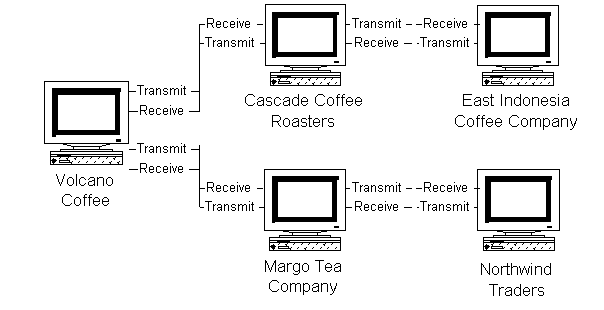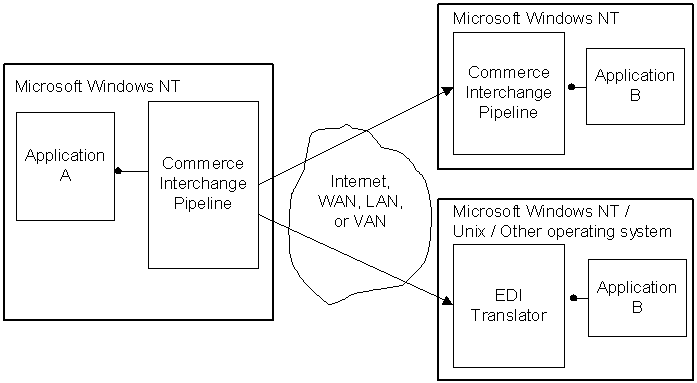



All businesses, whether large or small, depend on continuous and accurate communications with other businesses. Traditionally, these messages have taken the form of printed forms, letters sent by mail, or telephone calls. More recently, many large businesses have turned to electronic communications, such as the Electronic Data Interchange (EDI), for the transmission of certain business documents.
The Commerce Interchange Pipeline (CIP) simplifies the electronic communication of business data, enabling even small businesses to take advantage of the benefits of electronic data transmission without incurring the cost overhead of a value-added network. These benefits include greater accuracy, improved security, lower cost, and faster response times.
Any type of business transaction can be conducted electronically using the CIP. The following example illustrates how a business might use the CIP to communicate with another business, creating a large network of inter-related enterprises.
Suppose that a business named Volcano Coffee, a national chain of coffee and tea shops, needs to order a large supply of coffee beans from Cascade Coffee Roasters and tea from the Margo Tea Company.
Cascade Coffee Roasters may not have the stock on hand to immediately fill this order, so it may need to purchase part of the order fulfillment from the East Indonesia Coffee Company.
If the Margo Tea Company finds itself in a position similar to that of the Cascade Coffee Roasters, it may need to purchase from the Northwind Traders. The interactions among these companies may occur as follows.

In this illustration, Volcano Coffee sends its order over a transmit pipeline to Cascade Coffee Roasters. That company may or may not acknowledge having received the order. If it does, it will use its transmit pipeline to send a return receipt to Volcano Coffee, which will receive this return receipt on its receive pipeline. A similar series of transactions occurs between Cascade Coffee Roasters and its supplier, the East Indonesia Coffee Company, and between the Margot Tea Company and its supplier, Northwind Traders.
This scenario, which is an example of the supply-chain, could be expanded to encompass any number of trading partners. Regardless of the number or configuration of trading partners involved, the sequence of operations, as well as the structure of the business data objects exchanged among these trading partners, is dictated by the ordinary course of business, rather than by any limitations imposed by the software.
Although the preceding illustration is commerce-based, nothing in the CIP model ties it specifically to commerce. The CIP model fits into any scenario that requires the automated exchange of data.
The CIP Transmit and Receive pipelines can run on distinct sites on separate servers, or can exist on the same server. In fact, the Transmit pipeline does not necessarily have to transmit its data to a Receive pipeline, nor does a Receive pipeline necessarily have to receive its data from a Transmit pipeline. A Transmit pipeline needs only to transmit to some software component (such as an EDI translator) that is designed to interpret the data sent, and the Receive pipeline needs only to know how to interpret the data it receives.
The following diagram illustrates how a CIP, running under Microsoft Windows NT, can communicate either with a CIP on another computer running Windows NT, or with an EDI translator running under any operating system.
